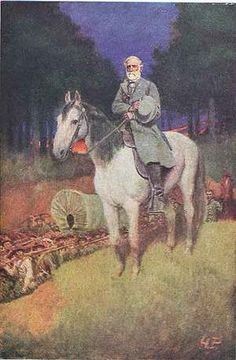At one point, he chuckled somewhat incredulously and murmured, "Bless her! I do believe my mother saved every newspaper she ever received."
Finally, he found what he was looking for and taking it to his desk, he gently spread the old paper out, picked up his pen and began to consolidate the account for Fredrick.
My Dearest Grandson,
As promised, today's letter contains an account of the fall of Port Royal to the Federals. You will recall that General Lee had taken command of the Department of South Carolina, Georgia, and East Florida just days prior to this engagement.
Before I actually take you too the attack, Fred, allow me to give a little groundwork for it. This was the third attack on Confederate ports. It would also be the third success. The previous two were Hatteras Inlet (North Carolina) and Ship Island off New Orleans. These engagements took place in August and September, respectively; but our purpose here is not to draw out the details of those attacks at this point.
The commanding officer in charge of the Port Royal escapade was Captain Samuel DuPont. DuPont set sail from Hampton Roads in late October with sealed orders and 74 vessels plus a landing force of 12,000.
One way or another, the target of the expedition was discovered by our intelligence men and Forts Walker and Beauregard were duly warned. The weather caused problems for DuPont, whose fleet ran into a severe storm which scattered his shipping. By the 7th, he was anchored just outside the bay and many of his ships had found their way back to him. He was ready for an attack that no longer contained an element of surprise.
Thursday, 7 Novemeber, 1861. Eight o'clock a.m.
Captain Samuel DuPont commenced his ingenious battle plan. I will here attempt a sketch at a battle map for you.

Mr. Hamilton painstakingly traced a map he had found...and scratched in the Federal maneuvers. Satisfied, he returned to his writing.
As you will be able to see, DuPont's plan consisted of an expanding elliptical line of attack--his gunboats raking the forts with each pass.
He divided his ships into a main squadron, consisting of nine of the heaviest of the frigates and sloops, and a flanking squadron of five gunboats. These all entered the sound in parallel columns, the lighter squadron ranged to starboard. As they passed midway between the forts, Beauregard on the north, Walker three miles to the south, the gunboats were the target of the fort's fire, but they returned said fire vigorously.
Roughly two miles into the sound, the main force turned to the south and came round to move past Fort Walker, the weaker of the two forts, while keeping up a scathing cannonade. They continued this maneuver all the way around in a giant ellipses to give Fort Beauregard the same treatment.
While the above maneuvering was underway, the flanking squadron peeled off to engage the four Confederate boats--three of which were no more than tugs mounting but a single gun apiece! These gunboats, after firing once or twice, promptly retreated up Skull Creek...where they were essentially useless to the fight, being bottled up by the Yankee boats.
Regrettably for our side, the gunners in the forts had had little to no practice with their artillery pieces. No only were they unskilled in the handling of their guns, it soon became apparent that the shot was frequently of the wrong size and the quality of the power was quite poor. It may be needless to remark at this point that the toll they took on the Union vessels was extremely light.
To make matters worse, Fort Walker was rather weak on the northern side as the it had been built primarily for the purpose of defending directly out to sea and no more. DuPont had discovered this and thereby concentrated his fire upon the northward side of the fort. The gunboats which had the Confederates bottled up in Skull Creek were able to assist in the cannonade of Fort Walker's northern wall from where they were stationed.
By early afternoon, Fort Walker was unable to withstand the Yankee fire and thereby lowered her flag. At 2:20 the Federals, having landed, raised the Union flag over the ramparts of the damaged fort. At sunset, Fort Beauregard likewise lowered her flag. DuPont would occupy it the following morning.
The battle was over. The Confederacy had lost a third port. However, for reasons that I cannot elucidate upon, the Union would never exploit their hold in the heart of secessionist county was well as they might have--at least on land--though indeed Port Royal served them well as a base for the blockading Union fleet.
The casualties were light on both sides. The Confederates suffered 11 killed, 48 wounded, 3 captured, and 4 missing. The Federals: 8 killed and 23 wounded.
.....
Your loving grandfather,
James B. Hamilton

 RSS Feed
RSS Feed

